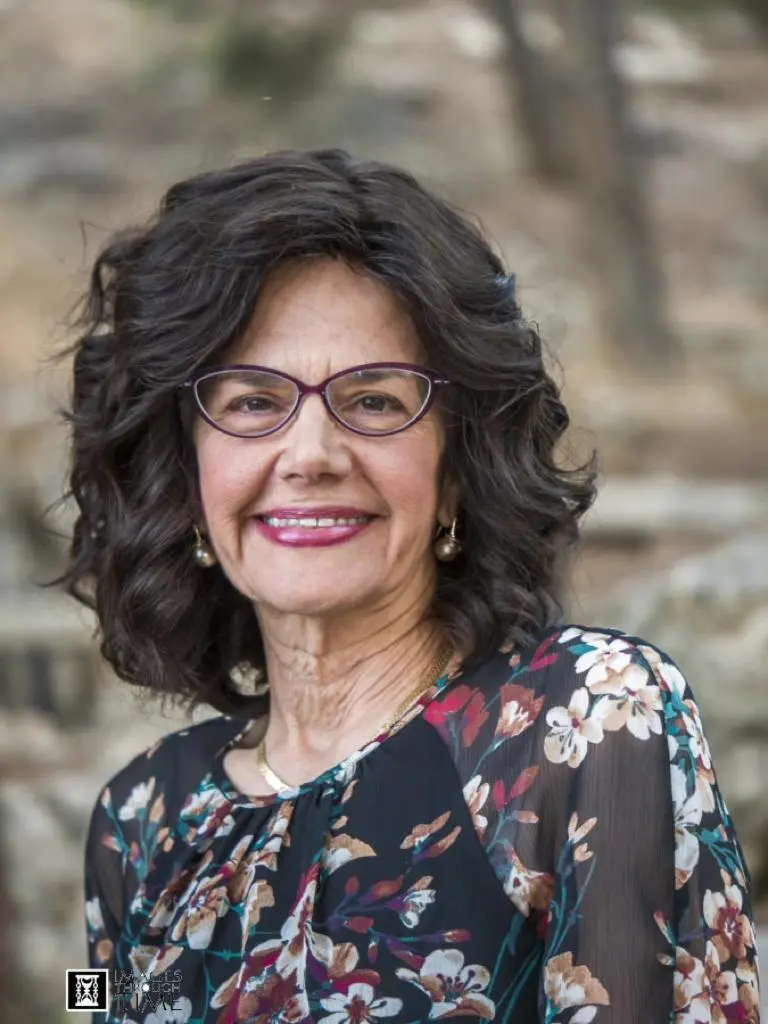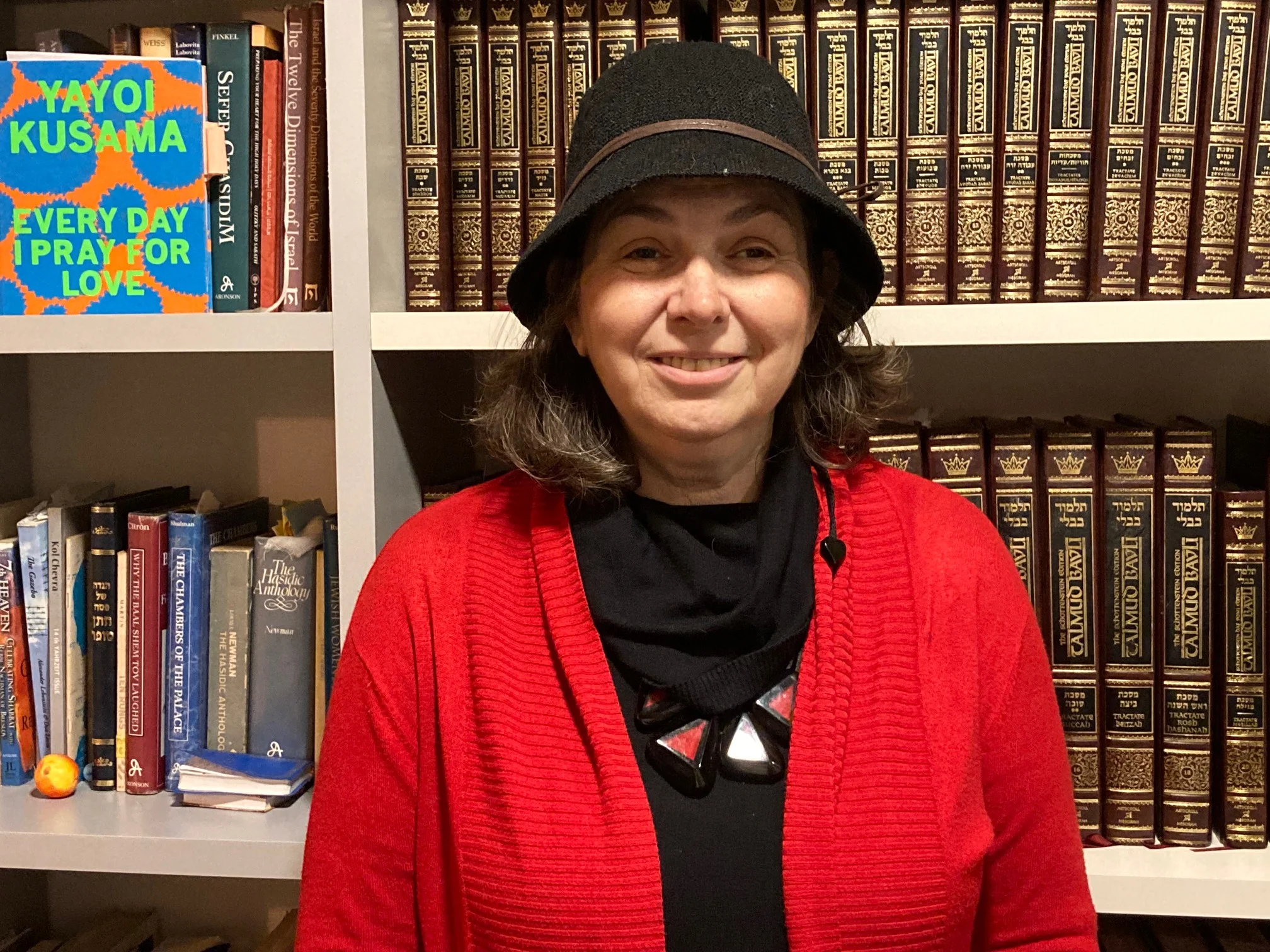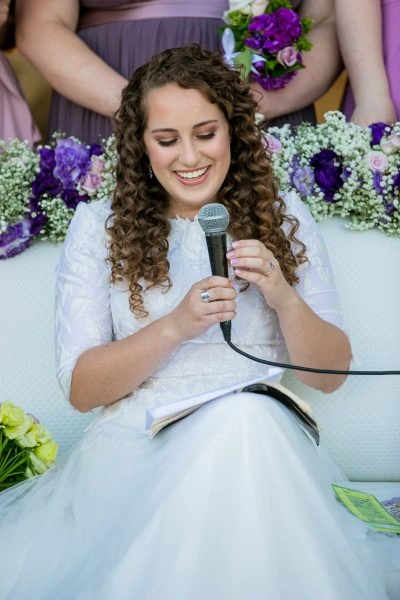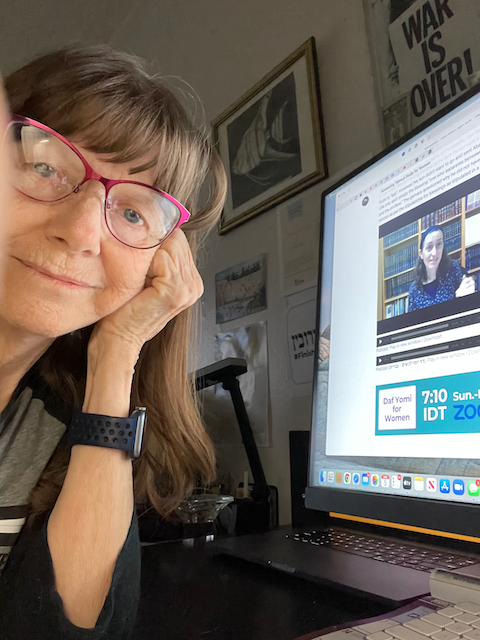What types of shoes can be used for chalitza? What are the different opinions? In what situations with a defect in one’s feet/legs can a person not do chalitza? The laws for going to the Temple on the holidays seem to be different than the laws here – why? Why does the halacha distinguish between a leg cut off by the thigh and one cut off by the shin? Several verses in the Torah are brought to show that legs could also refer to the upper part of the leg, however, they are mostly understood to be used as euphemisms and therefore not relevant to the discussion. The verse relating to Yael’s seduction of Sisra is mentioned and a question is asked about her actions. One can use a shoe that isn’t his own – but it is not ideal. What is the best way to do it? Two versions are brought about Rava’s opinion regarding a leprous shoe – if it is used for chalitza, it is valid?
This week’s learning is sponsored by Robert and Paula Cohen in loving memory of Joseph Cohen, Yosef ben Moshe HaCohen, z”l. “He was hard working, loved to sing, esp. as a chazan, and was very dedicated to his family and community.”
Want to dedicate learning? Get started here:


Summary
Today’s daily daf tools:
This week’s learning is sponsored by Robert and Paula Cohen in loving memory of Joseph Cohen, Yosef ben Moshe HaCohen, z”l. “He was hard working, loved to sing, esp. as a chazan, and was very dedicated to his family and community.”
Today’s daily daf tools:
Delve Deeper
Broaden your understanding of the topics on this daf with classes and podcasts from top women Talmud scholars.
New to Talmud?
Check out our resources designed to help you navigate a page of Talmud – and study at the pace, level and style that fits you.
The Hadran Women’s Tapestry
Meet the diverse women learning Gemara at Hadran and hear their stories.
Yevamot 103
בֵּין עוֹמֵד, בֵּין יוֹשֵׁב, בֵּין מוּטֶּה, וְהַחוֹלֶצֶת מִן הַסּוֹמֵא — חֲלִיצָתָהּ כְּשֵׁרָה. אֲבָל בְּמִנְעָל הַנִּפְרָם שֶׁאֵין חוֹפֶה אֶת רוֹב הָרֶגֶל, בְּסַנְדָּל הַנִּפְחָת שֶׁאֵינוֹ מְקַבֵּל אֶת רוֹב הָרֶגֶל, וּבִסְמִיכַת הַיָּדַיִם, וּבְאַנְפִּילְיָא שֶׁל בֶּגֶד, וְחוֹלֶצֶת מִן הַקָּטָן — חֲלִיצָתָהּ פְּסוּלָה.
whether the yavam is standing or sitting or leaning; and a woman who performs ḥalitza on a blind yavam; in all of these cases her ḥalitza is valid. But if she performs ḥalitza when he is wearing a shoe that is so torn that it does not cover most of the foot; or using a broken sandal that does not hold most of the foot; or using a hand blanket that the amputee wears on his hands, similar to a leather shoe, in order to drag himself using them; or using a soft shoe [anpileya] made of cloth; or a woman who performs halitza with a yavam who is a minor; in all these cases her ḥalitza is disqualified.
קַב הַקִּיטֵּעַ, מַנִּי — רַבִּי מֵאִיר הִיא, דִּתְנַן: הַקִּיטֵּעַ יוֹצֵא בְּקַב שֶׁלּוֹ, דִּבְרֵי רַבִּי מֵאִיר. רַבִּי יוֹסֵי אוֹסֵר.
The Gemara comments: Who is the tanna who holds that an amputee’s prosthetic is considered a shoe? It is Rabbi Meir, as we learned in a mishna (Shabbat 65b): One with an amputated leg may go out on Shabbat with his wooden leg, as it has the legal status of a shoe; this is the statement of Rabbi Meir. He reasons that the prosthesis functions like the shoe of any other person, indicating that Rabbi Meir is not especially concerned about the material from which the shoe is made. And Rabbi Yosei, on the other hand, prohibits the amputee from going out on Shabbat with his wooden leg, as he does not consider it a shoe that is being worn, but rather a wooden object that is being carried.
בְּאַנְפִּילְיָא שֶׁל בֶּגֶד, אֲתָאן לְרַבָּנַן!
The Gemara asks how Rabbi Meir can be the tanna of the baraita, as the continuation of the baraita states ḥalitza is disqualified if performed with an anpileya made of cloth, as this cloth shoe is not to be considered a shoe. If so, have we come to the opinion of the Rabbis, who rule in accordance with Rabbi Yosei, and render it prohibited to use any shoes for ḥalitza that are not made of leather?
אָמַר אַבָּיֵי: מִדְּסֵיפָא רַבָּנַן, רֵישָׁא נָמֵי רַבָּנַן. וְרֵישָׁא, בִּמְחוּפֶּה עוֹר.
In an attempt to resolve the contradiction Abaye said: Since the latter clause of the baraita is in accordance with the Rabbis, who rule like Rabbi Yosei, the first clause is also in accordance with the Rabbis. And therefore the first clause, which permits the amputee’s prosthesis, is referring to a prosthetic foot covered in leather, as it constitutes a shoe due to its leather exterior.
אֲמַר לֵיהּ רָבָא: אֲבָל אֵין מְחוּפֶּה עוֹר, מַאי — פָּסוּל? אִי הָכִי, אַדְּתָנֵי סֵיפָא בְּאַנְפִּילְיָא שֶׁל בֶּגֶד, לִיפְלוֹג בְּדִידַהּ: בַּמֶּה דְּבָרִים אֲמוּרִים: בִּמְחוּפֶּה עוֹר, אֲבָל אֵין מְחוּפֶּה עוֹר — פָּסוּל!
Rava said to him: But according to your explanation, if the prosthesis is not covered in leather, what would its status be? It would be unfit. If so, rather than teaching in the latter clause: Anpileya made of cloth is invalid for ḥalitza, let it distinguish within the matter itself and say: In what case is this statement that a wooden prosthesis is fit said? It is in the case of a prosthetic leg covered in leather, but if it is not covered in leather, it is unfit.
אֶלָּא אָמַר רָבָא: מִדְּרֵישָׁא רַבִּי מֵאִיר, סֵיפָא נָמֵי רַבִּי מֵאִיר: הַאי — מַגֵּין, וְהַאי — לָא מַגֵּין.
Rather, the fact that the baraita was not taught in that manner indicates that Abaye’s explanation is incorrect. Therefore, Rava said that the contradiction should be reconciled in another way: Since the first clause of the baraita is in accordance with the opinion of Rabbi Meir, that the shoes need not be made of leather, the latter clause is also taught in accordance with the opinion of Rabbi Meir, and the distinction between a wooden prosthetic and an anpileya of cloth is: This prosthesis protects the foot, and that soft shoe does not protect the foot, as it does not have a hard sole. Rabbi Meir does not require that the shoe be of leather, but he does require that it be protective footwear.
אָמַר אַמֵּימָר: הַאי מַאן דְּחָלֵיץ, צָרִיךְ לְמִדְחֲסֵיהּ לְכַרְעֵיהּ.
With regard to the statement in the baraita that indicates that ḥalitza may be performed even if the yavam is not standing, Ameimar said: The one who performs ḥalitza by having his yevama remove his shoe must press his foot to the ground, and while in this position the yevama will remove his shoe.
אֲמַר לֵיהּ רַב אָשֵׁי לְאַמֵּימָר, וְהָתַנְיָא: בֵּין עוֹמֵד, בֵּין יוֹשֵׁב, בֵּין מוּטֶּה! אֵימָא: וּלְעוֹלָם דְּדָחֵיס לְכַרְעֵיהּ.
Rav Ashi said to Ameimar: But isn’t it taught in the baraita above: She may perform ḥalitza whether he was standing or sitting or leaning? One who is leaning cannot easily press his foot into the ground. He answered him: Say that the man may perform ḥalitza while in any of these positions, but that actually this is true only if he presses his foot to the ground, which is admittedly more difficult to do while leaning.
וְאָמַר אַמֵּימָר: הַאי מַאן דִּמְסַגֵּי עַל לִיחֲתָא דְּכַרְעֵיהּ, לָא חָלֵיץ. אֲמַר לֵיהּ רַב אָשֵׁי לְאַמֵּימָר, וְהָתַנְיָא: סְמִיכוּת הָרַגְלַיִם, לָאו דְּחָלֵיץ בַּהּ אִיהוּ? לָא, דְּיָהֵיב לֵיהּ לְאַחֵר וְחָלֵיץ.
And Ameimar also said about this issue: Someone who walks on the backs of his feet, meaning he is clubfooted and his foot is twisted upside down, cannot perform ḥalitza. Rav Ashi said to Ameimar: But isn’t it taught in a baraita: Leg supports can be used for ḥalitza. Does this not mean that this lame individual performs ḥalitza using these supports on his knees? This would indicate that even one with twisted feet can perform ḥalitza. The Gemara answers: No, the intention is that if he gave these supports to another whose foot is shaped normally and he wore them while performing ḥalitza, it is valid. That other one is allowed to perform ḥalitza while wearing these supports because they are also considered shoes, but one whose foot is misshapen may not perform ḥalitza with them, as it functions for him as a foot, not a shoe.
אָמַר רַב אָשֵׁי: לְמַאי דְּקָאָמַר אַמֵּימָר, לָאו בַּר אוֹבָא חָלֵיץ, וְלָאו בַּר קִיפוֹף חָלֵיץ.
Rav Ashi said: According to what Ameimar said, bar Uva cannot perform ḥalitza and bar Kipof cannot perform ḥalitza, as these two, who were famous eulogizers in Rav Ashi’s generation, had feet that became so crooked that they were unable to walk normally.
מִן הָאַרְכּוּבָּה וּלְמַטָּה כּוּ׳. וּרְמִינְהִי: רְגָלִים — פְּרָט לְבַעֲלֵי קַבִּין!
It was taught in the mishna that if one’s leg was amputated from the knee down and his yevama performed ḥalitza with him, the ḥalitza is valid. The Gemara raises a contradiction from a baraita that comments on the pilgrimage one makes to Jerusalem during a Festival. The Torah states: “Three Festivals [regalim] you shall celebrate for Me in the year” (Exodus 23:14). The baraita comments on the verse: Festivals are referred to in the verse as regalim, which literally means feet, indicating that one must actually make the pilgrimage to Jerusalem by foot [regel] during the Festival, which comes to exclude people who have prostheses. This indicates that a prosthetic foot is not called a regel, which seems to contradict the mishna that allows ḥalitza on a prosthetic from the knee down.
שָׁאנֵי הָכָא, דִּכְתִיב: ״מֵעַל רַגְלוֹ״. אִי הָכִי, לְמַעְלָה מִן הָאַרְכּוּבָּה נָמֵי! ״מֵעַל״, וְלָא מֵעַל דְּמֵעַל.
The Gemara answers: It is different here, with respect to ḥalitza, as it is written: “She removes the shoe from on his foot [me’al raglo]” (Deuteronomy 25:9), which indicates that not only can his actual foot be used for performing ḥalitza, but also the part above it, i.e., the calf. The Gemara objects: If that is so, that one may use a part of his leg above his foot to perform ḥalitza, then if one’s leg was amputated from above the knee, he should also be eligible for ḥalitza; and yet, the same mishna taught that only one with a leg amputated from below the knee is eligible for ḥalitza. The Gemara answers that the verse states: “From on his foot,” meaning above his foot, but not: From on that which is on his foot; the wording indicates that it can be above his foot until the knee, but not any further above that.
אָמַר רַב פָּפָּא: שְׁמַע מִינַּהּ, הַאי אִיסְתָּוִירָא עַד אַרְעָא נָחֵית. דְּאִי סָלְקָא דַעְתָּךְ מִיפְסָק פָּסֵיק, הָוֵה לֵיהּ אִיהוּ ״מֵעַל״, וְשׁוֹקָא מֵעַל דְּמֵעַל! אָמַר רַב אָשֵׁי: אֲפִילּוּ תֵּימָא מִיפְסָק פָּסֵיק, כֹּל דְּבַהֲדֵי כַּרְעָא — כְּכַרְעָא דָּמֵי.
Rav Pappa said: Learn from here that the heel bone [istavira] reaches to the ground where it connects to the foot, for if it enters your mind to say that it is separate and divided, and there is another bone in between, then that ankle bone is “from on the foot” and the calf would be prohibited for ḥalitza, as it would be considered: From on that which is on his foot. Rav Ashi said: Even if you say that it is separate and divided from the calf, because anything that is connected with the sole of the foot is considered like the foot, then the ankle is certainly part of the foot, making the calf the area that is “from on the foot.”
מִן הָאַרְכּוּבָּה וּלְמַעְלָה. מֵתִיב רַב כָּהֲנָא: ״וּבְשִׁלְיָתָהּ הַיּוֹצֵאת מִבֵּין רַגְלֶיהָ״! אָמַר אַבָּיֵי: בְּשָׁעָה שֶׁכּוֹרַעַת לֵילֵד, נוֹעֶצֶת עֲקֵבֶיהָ בְּיַרְכוֹתֶיהָ וְיוֹלֶדֶת.
It was taught in the mishna that if one’s legs were amputated from the knee and above, the ḥalitza is invalid. This implies that the regel includes the calf but not the thigh. Rav Kahana raised an objection from the verse: “And against her afterbirth that emerges from between her legs [ragleha]” (Deuteronomy 28:57), implying that regel includes even the thighs. Abaye said: The verse actually means between her feet, as when a woman crouches to give birth, she pushes her heels into her thighs and she gives birth, so it appears as if the fetus emerges from between her feet.
תָּא שְׁמַע: ״לֹא עָשָׂה רַגְלָיו וְלֹא עָשָׂה שְׂפָמוֹ״! לִישָּׁנָא מְעַלְּיָא. תָּא שְׁמַע: ״וַיָּבֹא שָׁאוּל לְהָסֵךְ אֶת רַגְלָיו״! לִישָּׁנָא מְעַלְּיָא.
The Gemara continues its challenge. Come and hear another verse: “He had neither dressed his feet [raglav], nor trimmed his beard” (II Samuel 19:25). The phrase “dressed his feet [raglav]” is referring to treating his pubic hair, implying that even the area around the thigh is referred to as regel. The Gemara answers: This is a euphemism. The Gemara attempts another challenge: Come and hear from another verse: “And Saul went in to cover his feet [raglav]” (I Samuel 24:3), meaning: To urinate, implying that regel refers even to the thighs. The Gemara answers: This is also a euphemism.
תָּא שְׁמַע: ״אַךְ מֵסִיךְ הוּא רַגְלָיו בַּחֲדַר הַמְּקֵרָה״! לִישָּׁנָא מְעַלְּיָא. ״בֵּין רַגְלֶיהָ כּוּ׳״! לִישָּׁנָא מְעַלְּיָא.
Come and hear the meaning of: His feet, from the following verse regarding the Moabite king, Eglon, which states: “Surely he is covering his feet [raglav] in the cabinet of the cool chamber” (Judges 3:24). The Gemara answers: This is a euphemism. The Gemara attempts another proof from a verse regarding Sisera’s encounter with Yael: “At her feet [ragleha] he sunk, he fell” (Judges 5:27), which indicates that they had sexual intercourse, and implies that regel includes the thigh. The Gemara answers: This is also a euphemism.
אָמַר רַבִּי יוֹחָנָן: שֶׁבַע בְּעִילוֹת בָּעַל אוֹתוֹ רָשָׁע בְּאוֹתוֹ הַיּוֹם, שֶׁנֶּאֱמַר: ״בֵּין רַגְלֶיהָ כָּרַע נָפַל שָׁכָב בֵּין רַגְלֶיהָ כָּרַע נָפָל בַּאֲשֶׁר כָּרַע שָׁם נָפַל שָׁדוּד״. וְהָא קָא מִתְהַנְיָא מֵעֲבֵירָה! אָמַר רַבִּי יוֹחָנָן מִשּׁוּם רַבִּי שִׁמְעוֹן בֶּן יוֹחַי: כׇּל טוֹבָתָן שֶׁל רְשָׁעִים —
The Gemara elaborates on what happened when Sisera was in Yael’s tent. Rabbi Yoḥanan said: That wicked man, Sisera, had sexual intercourse with Yael seven times that day, as it is stated: “At her feet he sunk, he fell, he lay; at her feet he sunk, he fell; where he sunk, there he fell down dead” (Judges 5:27). Each instance of the terms “sunk,” “fell,” or “lay” in the verse indicates an act of intercourse, as Yael sought to tire and weaken Sisera to enable her to kill him. The Gemara asks: But how could Yael do this even for the noble purpose of killing the wicked Sisera, as she derived pleasure from the transgression of licentious sexual relations with a gentile? Rabbi Yoḥanan said in the name of Rabbi Shimon ben Yoḥai: Every act that is a benefit for the wicked
רָעָה הִיא אֵצֶל צַדִּיקִים. שֶׁנֶּאֱמַר: ״הִשָּׁמֶר לְךָ פֶּן תְּדַבֵּר עִם יַעֲקֹב מִטּוֹב עַד רָע״, בִּשְׁלָמָא רַע — לְחַיֵּי, אֶלָּא טוֹב אַמַּאי לָא? אֶלָּא שְׁמַע מִינַּהּ: טוֹבָתָן שֶׁל רְשָׁעִים — רָעָה הִיא אֵצֶל צַדִּיקִים.
is a disadvantage for the righteous, as a righteous individual gains no pleasure from this so-called beneficial act. As it is stated by God to Laban: “Take heed to yourself that you speak not to Jacob either good or bad” (Genesis 31:24). Granted, speak no bad; this is rightly so, i.e., understandable. But speak no good? Why not? Rather, learn from here that even something that would be a good benefit to the wicked like Laban, is a disadvantage for the righteous.
בִּשְׁלָמָא הָתָם, דִּלְמָא מַדְכַּר לֵיהּ שְׁמָא דַּעֲבוֹדָה זָרָה. אֶלָּא הָכָא, מַאי רָעָה אִיכָּא?
The Gemara asks: Granted, there, in Laban’s words to Jacob, it is understandable that there could be a certain repulsive aspect to a wicked man speaking nicely to a righteous individual, as perhaps he will mention to him the name of the idol he worships and even though he means well, it still would repulse Jacob. But here, what disadvantage is there if she derives benefit from licentious relations with a wicked man?
דְּקָא שָׁדֵי בָּהּ זוּהֲמָא. דְּאָמַר רַבִּי יוֹחָנָן: בְּשָׁעָה שֶׁבָּא נָחָשׁ עַל חַוָּה הֵטִיל בָּהּ זוּהֲמָא. יִשְׂרָאֵל, שֶׁעָמְדוּ עַל הַר סִינַי — פָּסְקָה זוּהֲמָתָן. גּוֹיִם, שֶׁלֹּא עָמְדוּ בְּהַר סִינַי — לֹא פָּסְקָה זוּהֲמָתָן.
The Gemara answers: He implants filth in her and contaminates her, as her body accepts his semen. As Rabbi Yoḥanan also said, based on his understanding that the serpent seduced Eve into having sexual relations with him: When the serpent came upon Eve, he infected her with moral contamination, and this contamination remained in all human beings. When the Jewish people stood at Mount Sinai their contamination ceased, whereas with regard to gentiles, who did not stand at Mount Sinai, their contamination never ceased. Therefore, Yael was repulsed by the contamination that she allowed into her body, and she did not benefit from relations with Sisera.
חָלְצָה בְּמִנְעָל שֶׁאֵינוֹ שֶׁלּוֹ וְכוּ׳. תָּנוּ רַבָּנַן: ״נַעֲלוֹ״, אֵין לִי אֶלָּא נַעֲלוֹ. נַעַל שֶׁל כׇּל אָדָם, מִנַּיִן? תַּלְמוּד לוֹמַר: ״נַעַל״ — נַעַל מִכׇּל מָקוֹם.
§ It was taught in the mishna that if she performed ḥalitza using a shoe that was not his, the ḥalitza is valid. The Sages taught: From the verse “And remove his shoe from on his foot” (Deuteronomy 25:9), I have derived only that the yavam may wear “his shoe,” i.e., a shoe that belongs to him; from where do I derive that he may wear any person’s shoe? The verse states the words “shoe” and “shoe” twice: “And remove his shoe” (Deuteronomy 25:9), and “The house of he who had his shoe removed” (Deuteronomy 25:10), to teach us that in any case it is acceptable, i.e., the shoes of another person may also be worn for ḥalitza.
אִם כֵּן, מָה תַּלְמוּד לוֹמַר ״נַעֲלוֹ״? נַעֲלוֹ הָרָאוּי לוֹ. פְּרָט לְגָדוֹל שֶׁאֵין יָכוֹל לַהֲלוֹךְ בּוֹ, וּפְרָט לְקָטָן שֶׁאֵינוֹ חוֹפֶה רוֹב רַגְלוֹ, וּפְרָט לְסַנְדָּל הַמְסוּלְיָים שֶׁאֵין לוֹ עָקֵב.
But if so, what is the meaning when the verse states: “His shoe,” which seems to indicate that he must own the shoe that he is wearing? It teaches that one must wear “his shoe,” i.e., a shoe that is fitting for him, excluding a shoe so large that he is unable to walk in it, and excluding a shoe so small it does not cover most of his foot, and also excluding a heelless sandal [sandal hamesulyam], a sandal that has only a sole but does not have a heel and is not fit for walking.
אַבָּיֵי הֲוָה קָאֵי קַמֵּיהּ דְּרַב יוֹסֵף, אֲתַאי יְבָמָה לַחְלוֹץ. אֲמַר לֵיהּ: הַב לֵיהּ סַנְדָּלָךְ, יְהַיב לֵיהּ סַנְדָּלָא דִשְׂמָאלָא, אֲמַר לֵיהּ: אֵימַר דַּאֲמוּר רַבָּנַן, דִּיעֲבַד, לְכַתְּחִלָּה מִי אֲמוּר?
The Gemara relates: Abaye was standing before Rav Yosef and a yevama came to perform ḥalitza. Rav Yosef said to Abaye: Give the yavam your sandal so that the ḥalitza may begin. He gave him his left sandal. Rav Yosef said to him: Granted, one can say that the Sages said that it is permitted to perform ḥalitza with the left shoe after the fact, but did they say that it is also permitted ab initio?
אֲמַר לֵיהּ: אִי הָכִי, סַנְדָּל שֶׁאֵין שֶׁלּוֹ נָמֵי: אֵימַר דַּאֲמוּר רַבָּנַן דִּיעֲבַד, לְכַתְּחִלָּה מִי אֲמוּר? אֲמַר לֵיהּ: הָכִי קָאָמֵינָא לָךְ: הַב לֵיהּ וְאַקְנִי לֵיהּ.
He said to him: If so, then also with regard to a sandal that does not belong to him, say that the Sages said that it is permitted after the fact; however, did they say it is permitted as well to perform ḥalitza using another’s shoe ab initio? Rav Yosef said to Abaye: This is what I was saying to you: Give him your sandal and transfer ownership to him by giving it to him as a temporary gift so that it will be his, and therefore the ḥalitza will be performed in an ideal manner, without any question as to its validity.
סַנְדָּל שֶׁל עֵץ. מַאן תַּנָּא? אָמַר שְׁמוּאֵל: רַבִּי מֵאִיר הִיא, דִּתְנַן: הַקִּיטֵּעַ יוֹצֵא בְּקַב שֶׁלּוֹ, דִּבְרֵי רַבִּי מֵאִיר. רַבִּי יוֹסֵי אוֹסֵר. אֲבוּהּ דִּשְׁמוּאֵל אוֹמֵר: בִּמְחוּפֶּה עוֹר, וְדִבְרֵי הַכֹּל.
The mishna taught that if the yevama performed ḥalitza while the yavam was wearing a wooden sandal the ḥalitza is valid. The Gemara asks: Who is the tanna who taught that it is permitted to use a wooden sandal? Shmuel said: It is the opinion of Rabbi Meir, as we learned in a mishna (Shabbat 65b): One with an amputated leg may go out on Shabbat with his wooden leg, as it has the legal status of a shoe; this is the statement of Rabbi Meir. And Rabbi Yosei prohibits it, since he does not consider it to have the legal status of a shoe. Alternatively, the father of Shmuel says: Here the mishna is referring to a wooden sandal that is covered in leather, and all agree. This halakha was taught in accordance with all opinions, as even Rabbi Yosei agrees that the leather covering makes it a shoe.
אָמַר רַב פַּפִּי מִשְּׁמֵיהּ דְּרָבָא: סַנְדָּל הַמּוּסְגָּר — לֹא תַּחֲלוֹץ בּוֹ, וְאִם חָלְצָה — חֲלִיצָתָהּ כְּשֵׁרָה. סַנְדָּל הַמּוּחְלָט — לֹא תַּחֲלוֹץ בּוֹ, וְאִם חָלְצָה — חֲלִיצָתָהּ פְּסוּלָה.
Rav Pappi said in the name of Rava: One should not perform ḥalitza on a yavam wearing a quarantined sandal, i.e., a sandal examined by a priest who found its signs of leprosy to be inconclusive, and places the sandal in isolation for a waiting period of up to two weeks to see if clear indications of leprosy develop. But if she did perform ḥalitza while the yavam was wearing it, her ḥalitza is nevertheless valid after the fact. On the other hand, if the sandal with leprosy is a confirmed sandal, i.e., a sandal that was definitively ruled to have leprosy, one may not perform ḥalitza with it, and if she did perform ḥalitza while the man was wearing it, her ḥalitza is disqualified. As an object with confirmed leprosy must be burned, it is considered halakhically as if it were already burnt, and is consequently considered to lack the qualities of a shoe necessary for ḥalitza.
רַב פָּפָּא מִשְּׁמֵיהּ דְּרָבָא אָמַר: אֶחָד סַנְדָּל הַמּוּסְגָּר וְאֶחָד סַנְדָּל הַמּוּחְלָט — לֹא תַּחֲלוֹץ בּוֹ, וְאִם חָלְצָה — חֲלִיצָתָהּ כְּשֵׁרָה.
In contrast, Rav Pappa said in the name of Rava: With regard to both a quarantined sandal and a confirmed sandal the same halakha applies: She may not perform ḥalitza with it ab initio, but if she did perform ḥalitza with it, her ḥalitza is valid.
מֵיתִיבִי: בַּיִת הַמּוּסְגָּר — מְטַמֵּא מִתּוֹכוֹ. מוּחְלָט — מִתּוֹכוֹ וּמֵאֲחוֹרָיו. וְזֶה וָזֶה מְטַמְּאִין בְּבִיאָה.
The Gemara raises an objection to Rav Pappi’s version, from a mishna (Nega’im 13:4): A quarantined house, i.e., one in which a discoloration appeared and was then quarantined by a priest until it could be determined whether it would be deemed a confirmed house of leprosy or not, renders one who touches it ritually impure from within, i.e., if one touches the inside of the house he becomes ritually impure; a house with confirmed leprosy renders one impure not only from touching it inside from within, but additionally from touching it behind, by touching it on the outside; and both this and that, i.e., both a quarantined house and a confirmed house, impart ritual impurity through entering it, as one who enters into either house becomes ritually impure, even if he does not touch the walls.
וְאִי סָלְקָא דַעְתָּךְ כְּדִמְכַתַּת דָּמֵי — וְהָא בָּעֵינַן: ״וְהַבָּא אֶל הַבַּיִת״, וְלֵיכָּא!
The Gemara elaborates: And if it enters your mind to say that an item with confirmed leprosy is considered as if it were crushed and not intact due to the requirement to burn it, then in order to contract ritual impurity through entering a house with leprosy, we require that there be a house, as the verse states: “Moreover, one who enters the house…shall be ritually impure” (Leviticus 14:46)? And this requirement is not satisfied here, as the house confirmed with leprosy must be burned and consequently should be considered as if it is crushed and not intact.
שָׁאנֵי הָתָם, דְּאָמַר קְרָא: ״וְנָתַץ אֶת הַבַּיִת״, אֲפִילּוּ בִּשְׁעַת נְתִיצָה קָרוּי בַּיִת.
The Gemara answers: There it is different, as the verse states: “And he shall break down the house” (Leviticus 14:45), which teaches that even while it is being broken down it is still called a house, until it is totally destroyed. Therefore, although for other purposes, objects that are required to be burned are considered crushed, the verse explicitly teaches that a house confirmed with leprosy is considered intact with regard to its ability to transmit ritual impurity to those who enter it.
תָּא שְׁמַע: מַטְלֵית שֶׁיֵּשׁ בּוֹ שָׁלֹשׁ עַל שָׁלֹשׁ, אַף עַל פִּי שֶׁאֵין בּוֹ כְּזַיִת, כֵּיוָן שֶׁנִּכְנָס רוּבָּהּ לְבַיִת טָהוֹר — טִמְּאַתְהוּ. מַאי לָאו, מוּחְלֶטֶת? לָא, מוּסְגֶּרֶת.
Come and hear a proof from the Tosefta (Nega’im 7:3): If a rag that is three fingerbreadths by three fingerbreadths has a spot of leprosy, then even if it does not contain the minimum volume of an olive-bulk, once most of the rag enters a pure house it renders the house ritually impure. What, is it not referring to a rag with confirmed leprosy, implying that one should calculate its measurements even when its leprosy is confirmed and it is destined to be burned? The Gemara rejects this assumption: No, this is referring to a quarantined rag, which does not have to be burned and is consequently considered intact. It can be measured to determine if it has the minimum measurements required for imparting ritual impurity.
אִי הָכִי, אֵימָא סֵיפָא: הָיוּ בָּהּ כַּמָּה זֵיתִים, כֵּיוָן שֶׁנִּכְנַס מִמֶּנָּה כְּזַיִת לְבַיִת טָהוֹר — טִמְּאַתְהוּ,
The Gemara challenges: If you interpret it so, say the latter clause: If the rag was the volume of several olives, i.e., it was very thick and even a small section of the cloth was equal to an olive-bulk, when one olive-bulk of the rag enters a ritually pure house, even if it is a small portion of the rag, it renders the house ritually impure.
אִי אָמְרַתְּ בִּשְׁלָמָא מוּחְלֶטֶת, הַיְינוּ דְּאִיתַּקַּשׁ לְמֵת. אֶלָּא אִי אָמְרַתְּ מוּסְגֶּרֶת, אַמַּאי אִיתַּקַּשׁ לְמֵת?
Granted, if you say that the entire baraita is referring to a rag with confirmed leprosy, this is so because a confirmed leper is juxtaposed with and thereby compared to a dead person (Numbers 12:12), and therefore an olive-bulk of the rag causes ritual impurity just as an olive-bulk of a corpse does. But if you say it is speaking about a quarantined rag, why should it be juxtaposed to a dead person? There is no biblical source comparing a quarantined leper to a corpse, and therefore, there is no reason to think that an olive-bulk of a rag transmits ritual impurity. Only if the rag is of the minimum dimensions and the entire rag enters the airspace does it transmit ritual impurity.
שָׁאנֵי הָתָם, דְּאָמַר קְרָא: ״וְשָׂרַף אֶת הַבֶּגֶד״, אֲפִילּוּ בִּשְׁעַת שְׂרֵיפָה קָרוּי בֶּגֶד.
The Gemara answers: That is correct; the baraita is referring to a rag with confirmed leprosy, but nevertheless it is not difficult for Rav Pappi. Although generally objects that are required to be burnt are considered crushed even before they are burnt, this is not true with regard to a garment with leprosy. There the halakha for a garment that has confirmed leprosy is different, as the verse states: “And he shall burn the garment” (Leviticus 13:52), which indicates that even when it is being burned, it is still called a garment.
וְלִיגְמַר מִינֵּיהּ! אִיסּוּר מִטּוּמְאָה לָא גָּמְרִינַן.
The Gemara asks: If your interpretation above is correct, that a garment with confirmed leprosy can still transmit ritual impurity even though the object is to be burned and should be considered crushed, let us learn from this concerning a sandal that even after it has been definitively determined to have leprosy, it is still considered a shoe and should be eligible for ḥalitza, at least after the fact, in accordance with Rav Pappa’s opinion. The Gemara answers: We cannot derive a halakha of a prohibition from a halakha of ritual impurity, as these different areas of halakha cannot be compared. Therefore, although a garment with leprosy is considered intact with regard to the transmission of ritual impurity, that status cannot act as a source to teach that it is intact for the purpose of ruling that ḥalitza performed with a shoe with confirmed leprosy is valid.
אָמַר רָבָא, הִלְכְתָא: אֶחָד סַנְדָּל הַמּוּסְגָּר, וְאֶחָד סַנְדָּל הַמּוּחְלָט, וְאֶחָד סַנְדָּל שֶׁל עֲבוֹדָה זָרָה — לֹא תַּחְלוֹץ, וְאִם חָלְצָה — חֲלִיצָתָהּ כְּשֵׁרָה. שֶׁל תִּקְרוֹבֶת עֲבוֹדָה זָרָה,
The Gemara cites Rava’s final ruling: Rava said that the halakha is the same for a quarantined sandal, a confirmed sandal, and a sandal of idolatrous worship, i.e., a sandal that was placed on a statue of idolatrous worship; one should not perform ḥalitza with it, and if she did perform ḥalitza with it, her ḥalitza is valid. If, however, he was wearing a sandal that functioned as an offering of idolatrous worship, in that it was brought as a gift to an idol;





















